Restaurant Orana, Adelaide
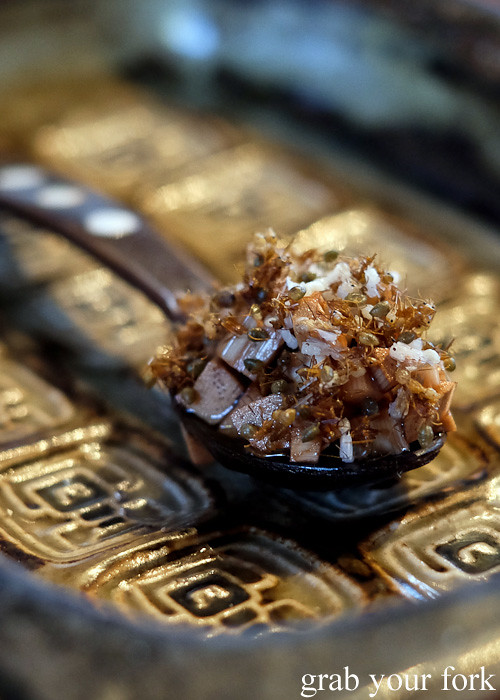
Green ants. Moreton Bay fig shoots. Wild Australian raspberries. Twenty courses. Nope, this isn't Noma but a cosy 31-seater in Adelaide. Restaurant Orana is doing what so few other Australia restaurants prioritise: celebrating local and native ingredients in an inventive and sophisticated way.
At the helm is Jock Zonfrillo, the Scotsman who flitted across our TV screens as the host of the cooking reality show, Restaurant Revolution. Zonfrillo's cooking credentials are substantial, working with Marco Pierre White (Restaurant Marco Pierre White in Knightsbridge and then Les Saveurs), David Cavalier (Michelin-starred Chapter One) and artist Damien Hirst (The Pharmacy).
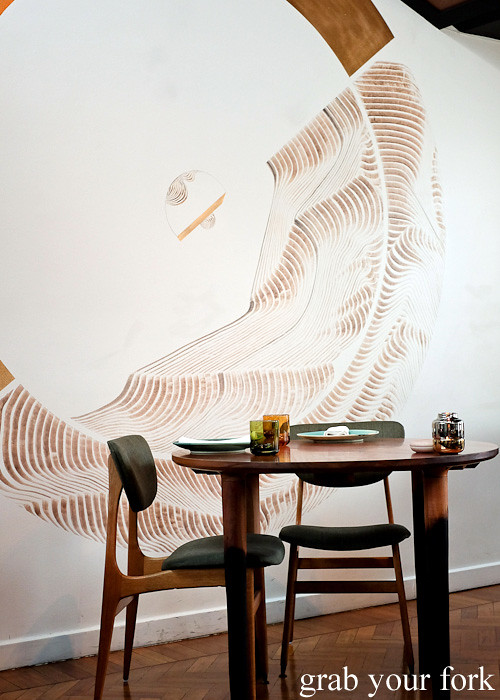
Retro styling in the dining room
At $175 per head for dinner, Orana is Adelaide's most expensive restaurant. I was intrigued enough by its menu that on my last trip to Adelaide (ok yes, it was in late 2015, but trust me, the backlog is real), I booked myself in as a solo diner.
I've dined alone plenty of times but facing a degustation on your own can feel a little intimidating at first. I have to give major props to the friendliness of staff here - they don't make a fuss over my lone dining status. The service is impeccable throughout the night, a combination of knowledgeable professionalism combined with a genuine sense of warmth. It's no coincidence that Orana means welcome in some Aboriginal languages.
Funnily enough about twenty minutes after I arrive, another single diner walks in and scores the last unsecured table. I'm galvanised by the fact I'm not the only party of one. A couple that arrives three minutes later without a booking is politely turned away.
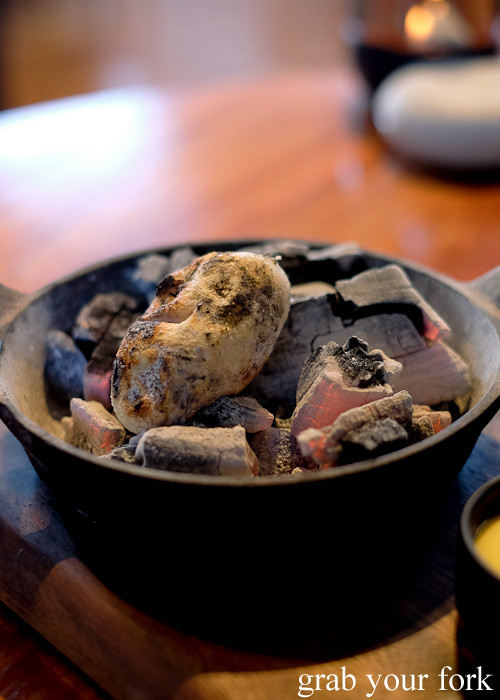
Cook-your-own potato damper on charcoal
The tasting menu begins with a series of alkoopina or snacks. These tend to arrive in trios, a clever way of steering diners through a 20-course tasting menu without enduring long waits in-between.
A cast iron pot glowing with charcoal is a dramatic start to dinner. Standing beside it is head chef Shannon Fleming. It's not until he motions towards it that I realise it is cooking my first course: potato damper.
He welcomes me to the restaurant and explains how to cook the damper. I'm privately taken aback that he's in the dining room, and watch as he appears at every other table with the same dish as the evening unfolds.
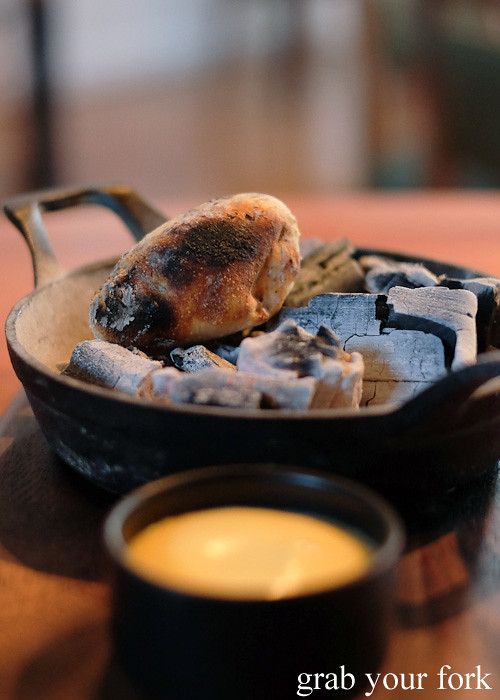
Potato damper after flipping
There's a childlike sense of play as I flip the damper with the wooden tongs supplied. And the intoxicating smell of charcoal makes you want to lean in and inhale deeply.
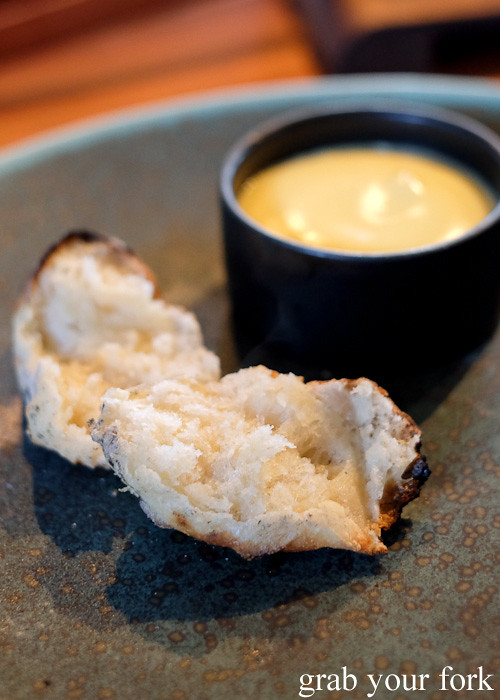
Potato damper with lamb butter
I rip open the crusty potato damper to reveal a soft and fluffy core. It's served with lamb butter, made from aged and roasted lamb fat. It's a terrific riff on two Australian mainstays.
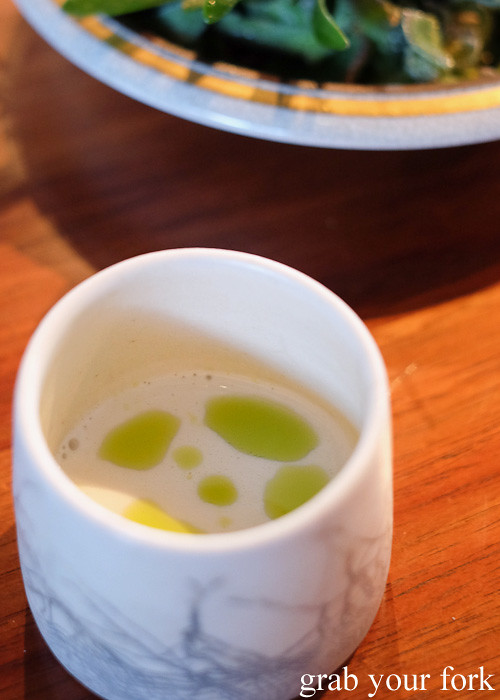
Macadamia and native thyme
Next is a cup of macadamia milk dotted with native thyme oil. The macadamia milk is sweet, nutty and silky in the mouth. Native thyme grows wild in south east New South Wales, eastern Victoria and in Tasmania.
It's worth noting, too, that no menu is provided at the start of the meal, maintaining an element of surprise for diners. This means you have to pay attention to waitstaff as each dish is described in impressive detail. A menu is eventually given to each diner when they leave.
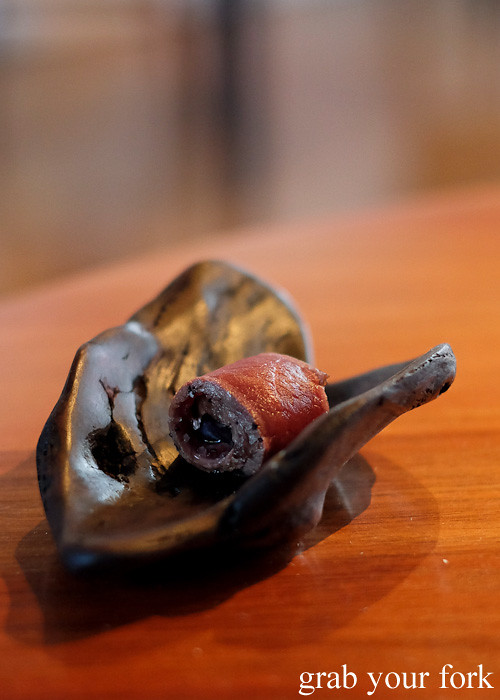
Venison, plum pine and mountain pepper
A scroll of venison arrives on a stand that looks more like a curled leaf. The tableware presented throughout the meal are all thoughtfully crafted. The rare venison has been seared on hot coals with Tasmanian mountain pepper, maintaining its delicate tenderness.
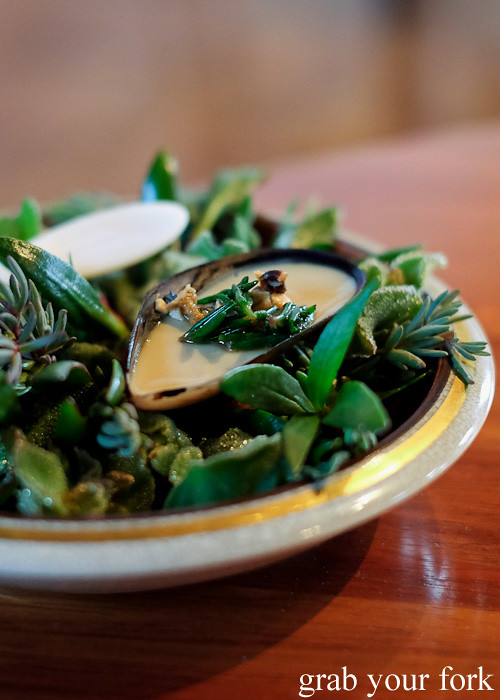
Mussel, granny smith apple and sea blight
There's only a brief interlude before the next trio arrives. A shallow bowl filled with succulents is the backdrop for a mussel shell filled with Boston Bay mussel custard and a Granny Smith apple reduction. Young shoots of sea blight give a salty crunch, amplifying the sense of being by the sea. The custard is velvety smooth.
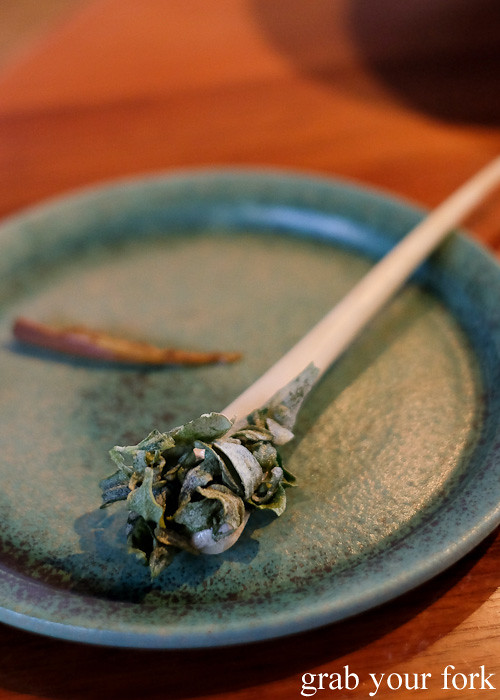
Saltbush, black garlic and creme fraiche and
Moreton Bay fig shoot and pandanus
A tiny Moreton Bay fig shoot is pickled and brushed with pandanus puree.
The next mouthful is a spoon of creme fraiche topped with black garlic and crispy saltbush. It's like a new take on chips and dip.
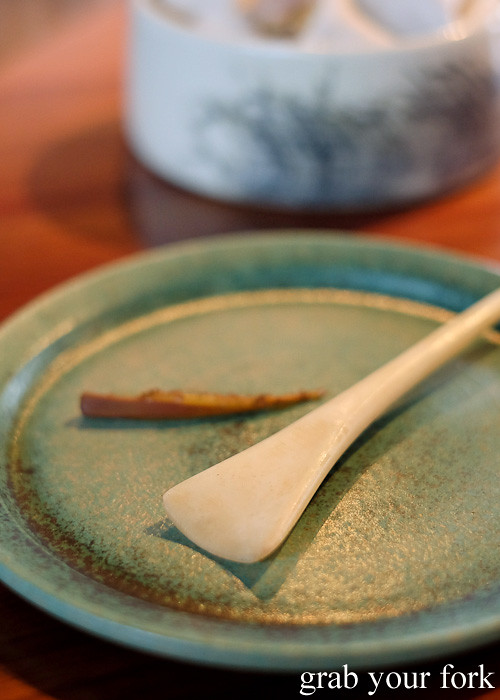
The spoon holding the saltbush made from lamb's femur
The spoon holding the saltbush is made from a lamb's femur, so beautifully made I can't help but take a photo.
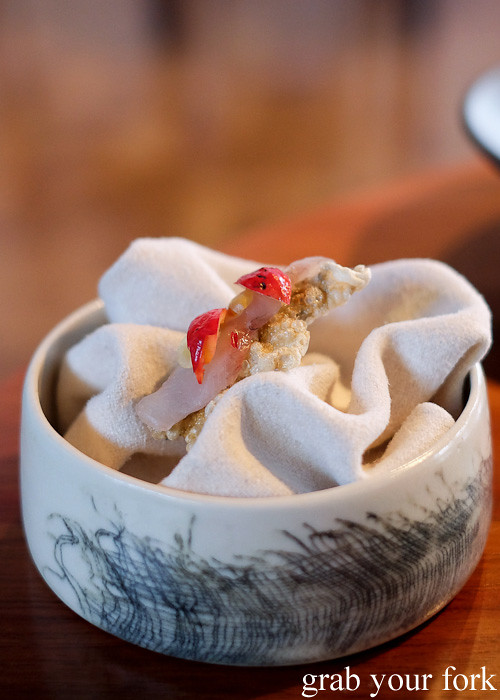
Mulloway, loganberry and quandong
A sliver of mulloway is served both raw and with its crispy skin. Tiny slices of quandong, a native desert peach, is brilliantly red in colour and refreshingly tart.
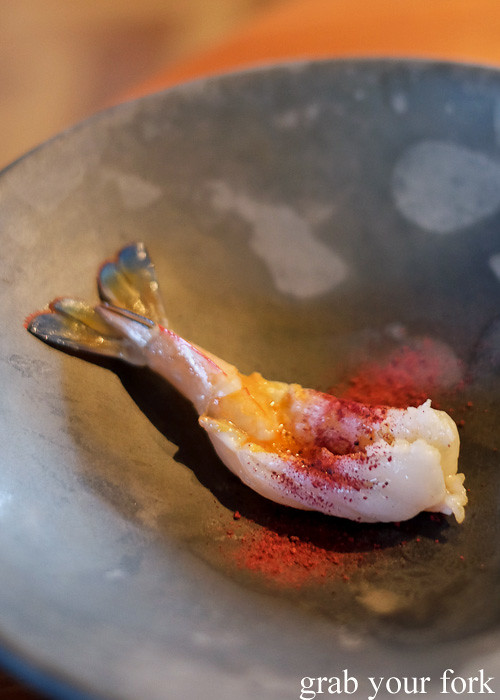
Spencer Gulf prawns and Davidson plum
The third trio begins with a Spencer Gulf prawn covered in a dust of Davidson plum sourced from far north Queensland. The plums are fermented and dehydrated, adding a mellow rhubarb-like tartness to the achingly sweet prawn.
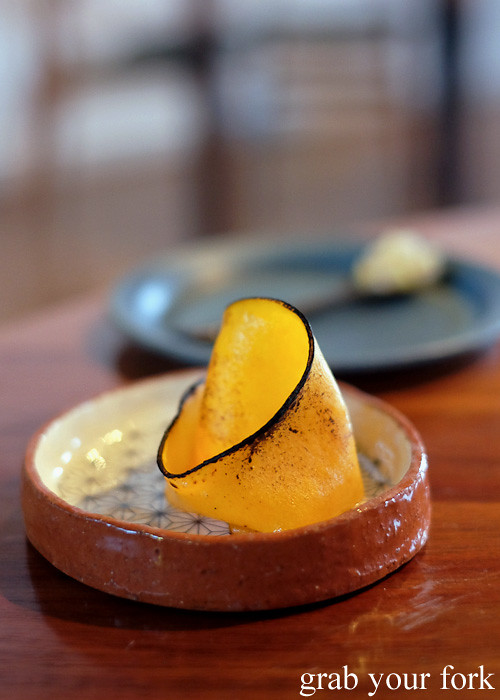
Roast beef and pumpkin
Roast beef and pumpkin is not what you expect, a curl of bright orange pumpkin that tastes inexplicably of roast beef.
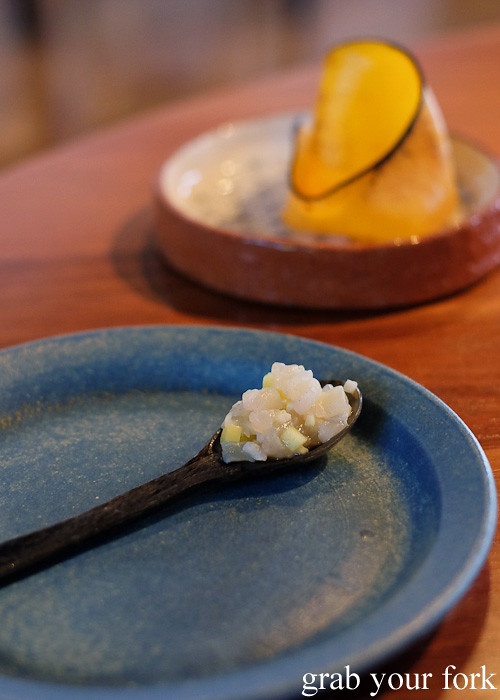
Pearl and green mango
I like the story behind the pearl and green mango too, using pearl meat that is a by-product of the pearl industry in Broome. Oysters are put out to pasture after two pearls are produced. The pearl meat - the abductor muscle of the pearl oyster - has a gentle chewiness that is lifted by the zippy freshness of green mango.

Alexander palm heart, native honey and green ants
A spoonful of green ants includes both ants and ant larvae. Mixed in amongst them are Alexander palm heart and native honey. I'm told that the green ants come from Elcho Island just off the coast of Arnhem Land. The ant nest is frozen and the ants are dehyrated before transport. The ants themselves are very aggressive otherwise.
The taste? They taste refreshingly of lemon. The green butt of the ant (hence their name) is where the lemony taste is most prominent.
Aborigines would often use green ants to flavour water (hello lemon water!). They're also apparently used as a traditional medicine to treat ulcers.
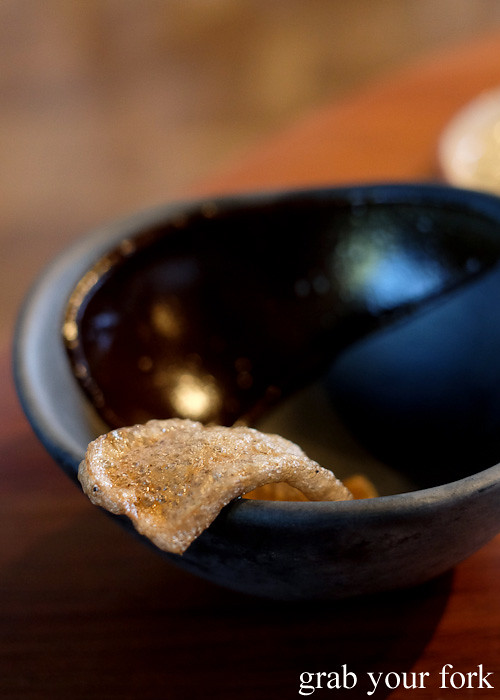
Kangaroo tendon and native peppers
I move onto kangaroo tendon, cooked, dehydrated and then deep-fried into a puffed up cracker, served with a swipe of pepper berry sauce along one side of a bowl.
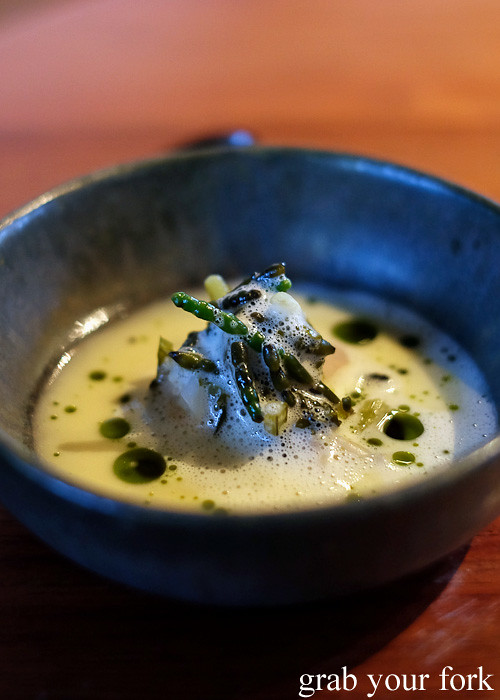
Pippies, samphire and marchcress
More theater arrives with an aromatic cockle broth poured over lightly smoked Goolwa cockles (or pippies). The foam reminds me of waves crashing at the beach, drenching an outcrop of marchcress and samphire. Floating dots of sea parsley oil taste remarkably similar to European parsley.
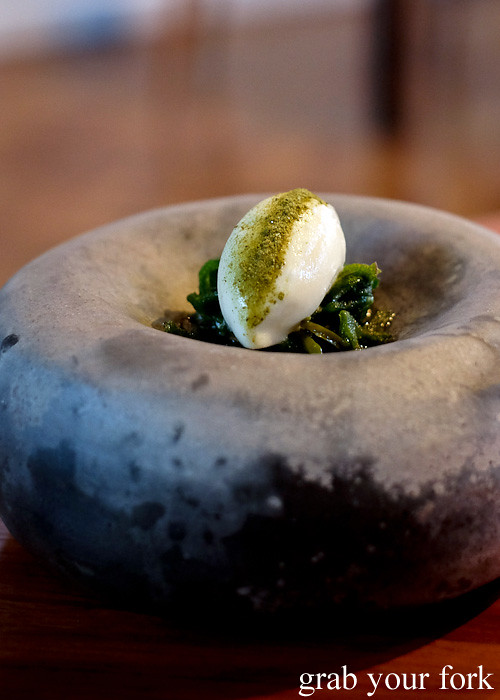
Crab and yoghurt sorbet, sea lettuce and sea purslane
And what looks like an indented stone bears a perfect quenelle of blue swimmer crab and yoghurt sorbet sitting on top of ice plants, sea lettuce and sea purslane. Ice plants are edible succulents that grow along the coast, so named because their colouring makes it look like they're covered in frost.
Who would have thought that crab and yoghurt would go together so well, especially in sorbet form? They do.
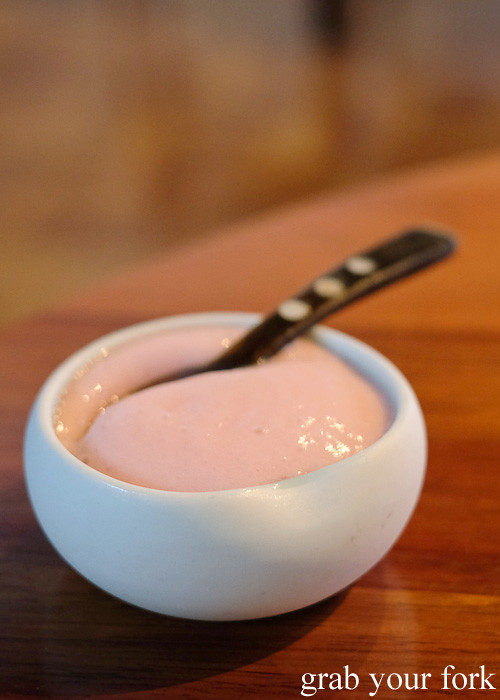
Davidson plum, desert lime, loganberry and tea tree
A fruit spritzer signals the end of the snack section.
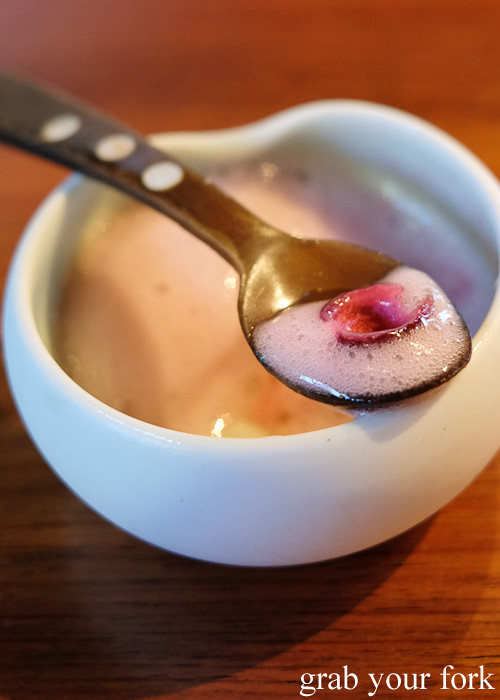
Davidson plum
Hidden at the bottom of the bowl is Davidson plum, a refreshing hit of tartness amidst desert lime, loganberry jelly and tea tree oil.
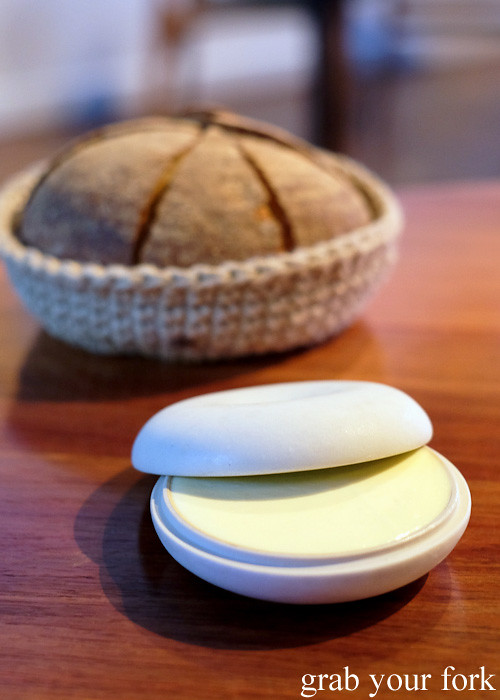
Hindmarsh Valley Dairy butter churned with extra buttermilk
I'd been curious about the white stone object on the table when suddenly the waiter prises it apart and I realises it contains butter. The pale creaminess is Hindmarsh Valley Dairy butter churned with extra buttermilk. Hindmarsh Valley Dairy is located on the Fleurieu Peninsula in South Australia.
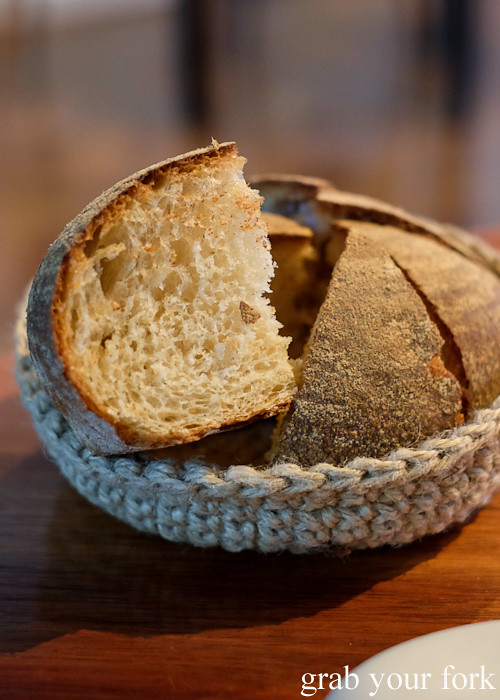
House-made sourdough
A loaf of house-made sourdough, still warm and crusty from the oven, is the ideal vehicle for that buttery goodness. The sourdough is baked inhouse daily with a wholewheat flour. It's incredibly good.
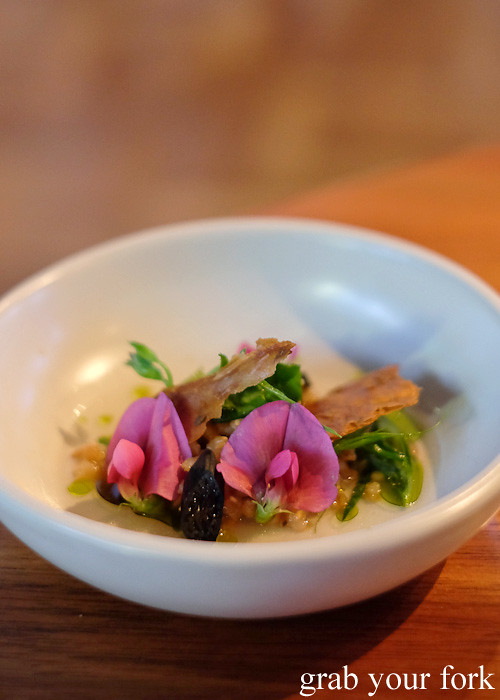
Spelt, tangia pea, water lily, mangrove seed, kutjera and saltbush
What looks like flower pickings from a garden turns out to be tangier pea flowers that are sweet and pea-like in flavour. The shallow dish holds a treasure trove of colours, flavours and textures including cooked spelt, brined mangrove seeds, water lily stems pickled in pandanus vinegar (the black object) and shards of saltbush puff pastry. The dressing has been made with kutjera berry, more commonly called a desert raisin or bush tomato.
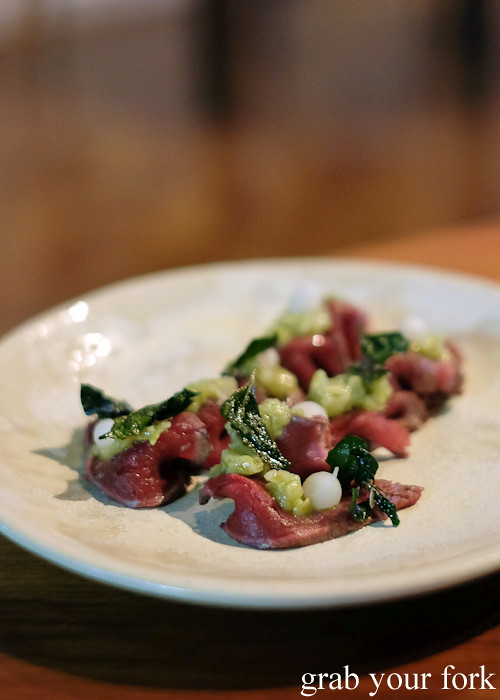
Charred kangaroo, gubinge, grasses and wild garlic
The next dish is red kangaroo from the east coast of New South Wales, bordering South Australia. The kangaroo has been cooked directly on hot coals adding smokiness while keeping the meat quite rare.
Wild garlic pearls from the Adelaide Hills have been pickled, adding a burst of acidity. Wild weeds, also from the Adelaide Hills, add a note of sourness. The puree is made from gubinge, a native stone fruit from the Western Kimberly, that has notes of tartness and sweetness.
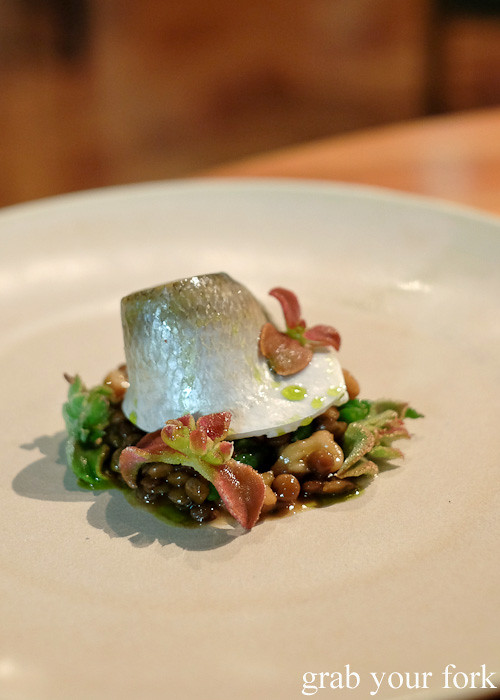
Coorong mullet, red lentils, walnut and ice plant
A fillet of Coorong mullet sits on a bed of red lentils, wild walnuts from the Adelaide Hills, Kangaroo Island honey and ice plants. I have definitely fallen in love with ice plants - they have a briny crunch to them that is highly addictive.
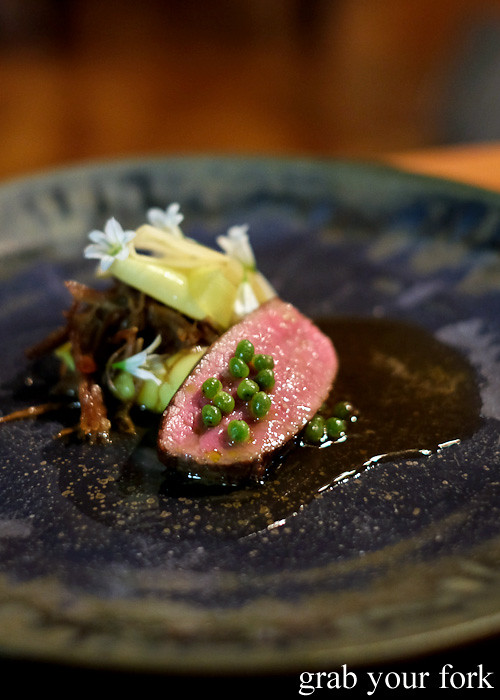
South Devon beef, native green currants, smoked potato and leek
The final savoury dish is presented by Matt, the junior sous chef, introduced by a member of waitstaff in a friendly transition. He explains that the South Devon beef rib eye has been aged for 40 days. It's pink and lusciously succulent.
The three veg here includes smoked mashed potato, charred leeks and wild garlic flowers from the Adelaide Hills. And those aren't green peas but sour green currants from New South Wales. Whilst at the table, he pours a white soy bunya nut brine with pandanus vinegar over the dish.
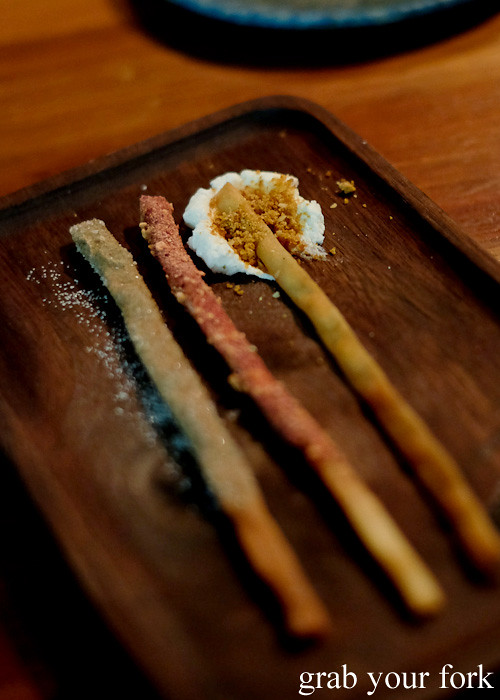
Pocky sticks! - cinnamon myrtle - quandong - honey and kutjera
Four courses of dessert arrive all at once. Pocky sticks have been given a cute overhaul with flavourings of cinnamon and myrtle; white chocolate and quandong; and wild honey and kutjera with buffalo curd.
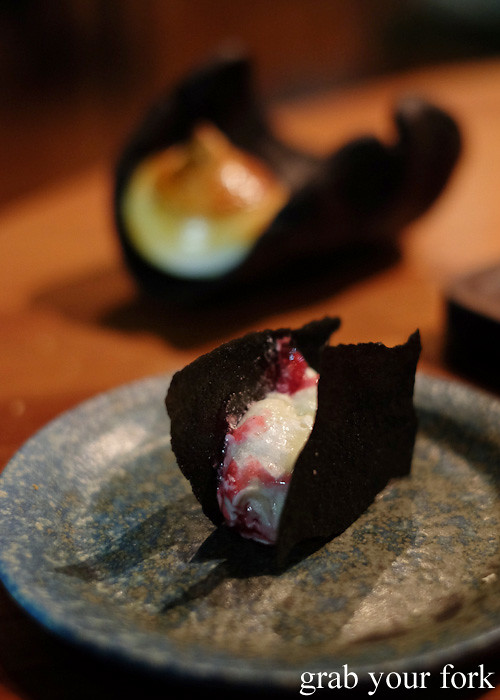
Native currant fool
I love the delicacy of the native currant fool encased within a black ash tuille. It's sweet and tart from the Atherton raspberry, a wild tropical raspberry native to Australia and Papua New Guinea.
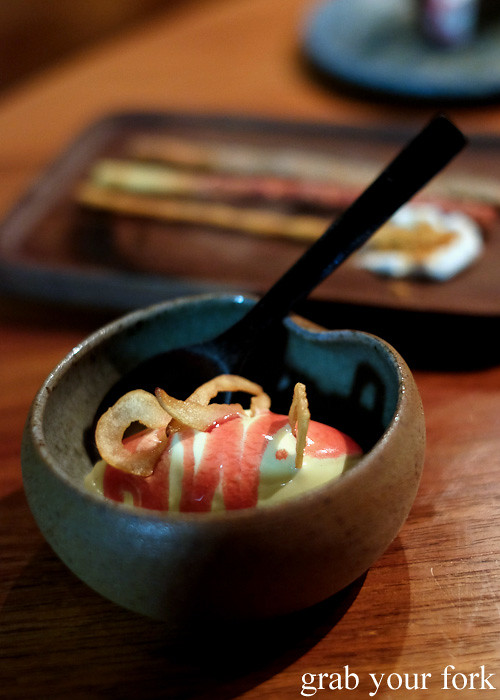
Bunya nut, Davidson plum and pine
Bunya nut ice cream is drizzled with Davidson plum molasses, pine oil and topped with fried bunya nuts for crunch.
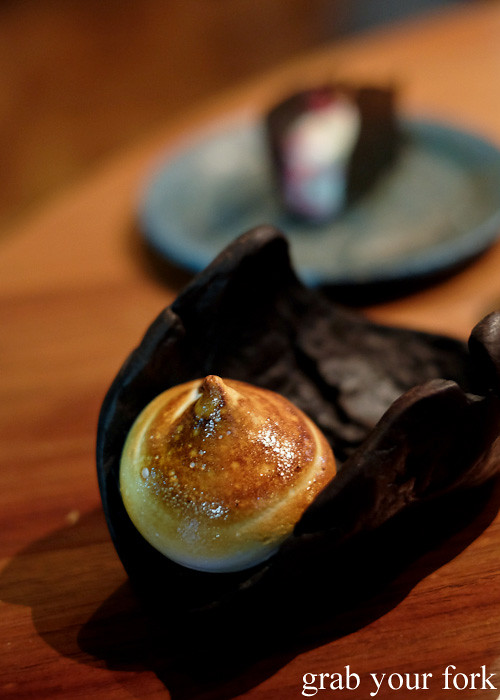
Feral coffee cherry marshmallow
The feral coffee cherry marshmallow is a sweet and sticky finale with its blowtorched and caramelised edges.
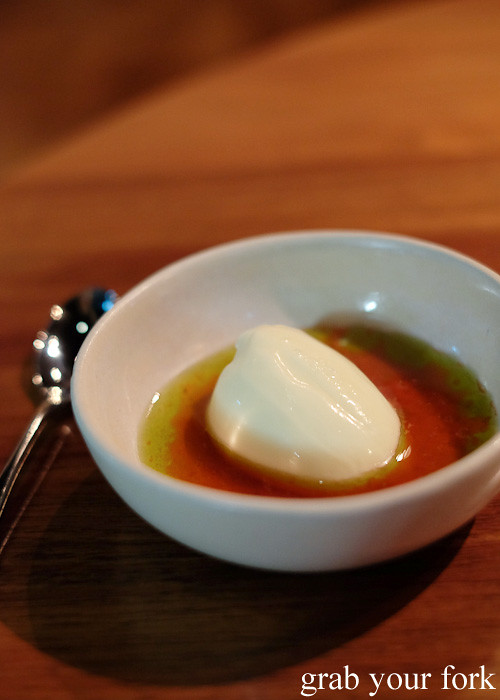
Set butermilk, strawberry and eucalyptus
Laura, the head pastry chef, arrives with the final course. It's a gentle palate cleanser of set buttermilk lightly seasoned with salt and vinegar. Strawberry and eucalyptus oil may seem like odd accompaniments but they work brilliantly. The milky creaminess of the buttermilk is gently comforting and an elegant finish to the meal.
I was entertained, intrigued and enlightened by this meal. For $175, I thought it was definitely worth it. There are approximately three menu changes per year so many of these dishes have since evolved. Some seasonal changes are made weekly.
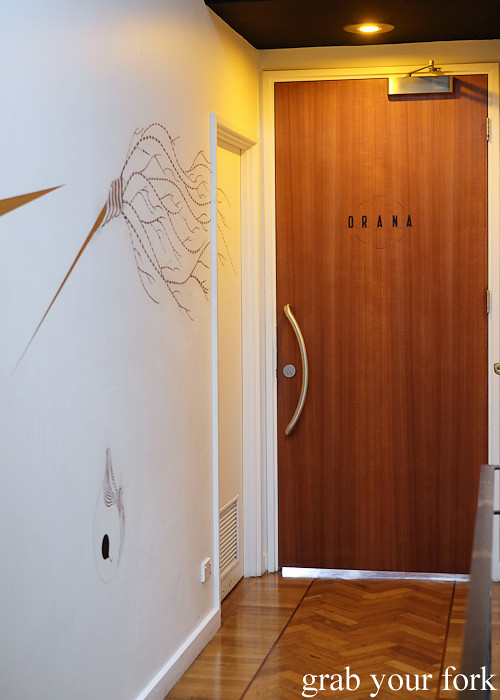
My cover story in SMH Good Food:
Sydney's Top 12 Noodle Soups
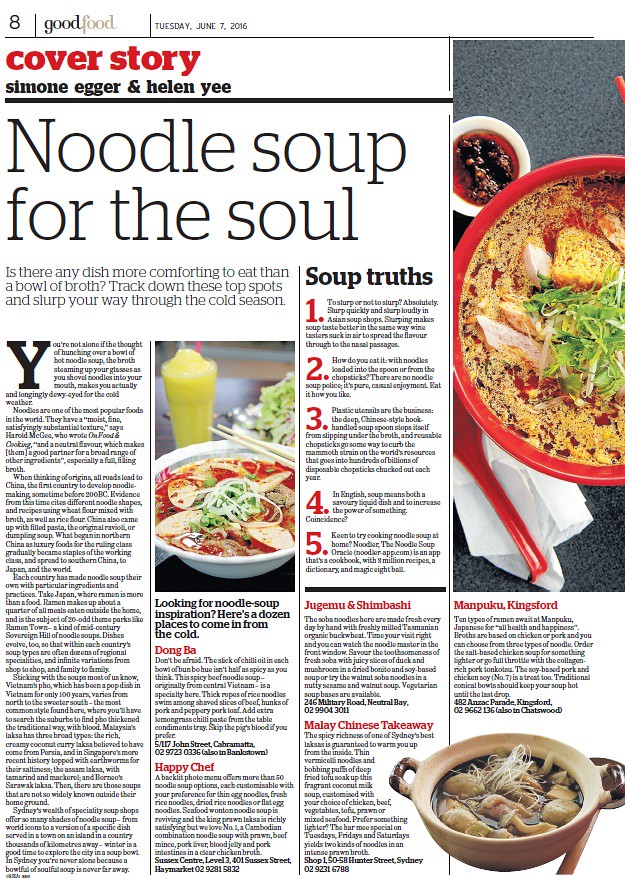
And with winter definitely upon us, do check out today's Good Food liftout in the Sydney Morning Herald for my cover story on Sydney's Top 12 Noodle Soups.
It was hard whittling down so many terrific noodle houses to just a dozen but I really tried to provide a good cross-section of cuisines and Sydney suburbs. You can read the full article here.
Did I miss one of your favourites? Let me know!
Restaurant Orana
Level 1, 285 Rundle Street, Adelaide, South Australia
Tel: +61 (08) 8232 3444
Opening hours
Lunch Friday 12pm-1.30pm
Dinner Tuesday to Saturday 6pm-8pm
Prices as at June 2016:
Lunch tasting menu on Fridays only:
$80pp for 7-9 courses
Add $70pp for wine matching. Add $35pp for non-alcoholic matches
Dinner tasting menu Tuesday to Saturday:
$175pp for 18-20 courses
Add $150pp for wine matching. Add $75pp for non-alcoholic matches
Related Grab Your Fork posts:
Adelaide - Abbots & Kinney
Adelaide - Press Food and Wine
posted by Helen (Grab Your Fork) on 6/07/2016 02:10:00 am





6 Comments:
At 6/07/2016 10:24 am, Unknown said…
Unknown said…
I take my hat off to Shannon and his team for creating such beautiful little morsels of Australia.
At 6/07/2016 10:54 am, chocolatesuze said…
chocolatesuze said…
roasted lamb fat sounds so amazing on that damper!
At 6/08/2016 8:24 am, John - heneedsfood said…
John - heneedsfood said…
That's got to be the most comprehensive usage of native flora and fauna in a restaurant I've ever seen. Brilliant stuff, even down to the organic nature of the stoneware. I love that woven bread basket!
At 6/13/2016 10:54 am, Berny @ I Only Eat Desserts said…
Berny @ I Only Eat Desserts said…
The food at Orana looks and sounds amazing - such interesting Australian ingredients! I'm not sure how game I would be to try the ants haha
Btw, congrats on the cover story! How exciting :D
At 6/25/2016 9:58 pm, irene said…
irene said…
Everything looks so dainty and beautiful! The house baked sourdough and the velvety-looking butter just sounds so good.
At 7/08/2016 7:41 pm, Sarah said…
Sarah said…
What a creative and intriguing meal! Looks like it would be def worth the $175! xox
Post a Comment
<< Home